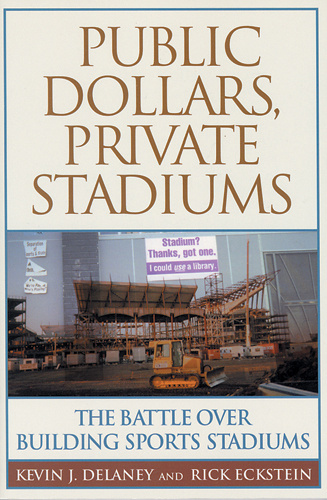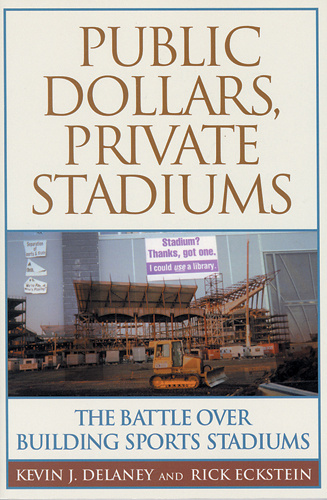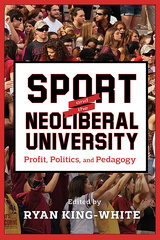Public Dollars, Private Stadiums
The Battle over Building Sports Stadiums
By Kevin J. Delaney and Rick Eckstein
Rutgers University Press
The authors provide an eye-opening account of recent battles over publicly financed stadiums in some of America’s largest cities. Their interviews with the key decision makers present a behind-the-scenes look at how and why powerful individuals and organizations foist these sports palaces on increasingly unreceptive communities.
Delaney and Eckstein show that in the face of studies demonstrating that new sports facilities don’t live up to their promise of big money, proponents are using a new tactic to win public subsidies¾intangible “social” rewards, such as prestige and community cohesion. The authors find these to be empty promises as well, demonstrating that new stadiums may exacerbate, rather than erase, social problems in cities.
Public Dollars, Private Stadiums helps us understand the political processes involved in using public money for new sports stadiums. It is a must read for anyone interested in this important new issue.
This book is readable and smart . . . Kevin Delaney and Rick Eckstein show how conflicts over sports subsidies are emblematic of the kinds of power relationships that prevail in each community.
Every time you hear a politician or millionaire sports mogul start to promote the benefits of building a brand-spanking new stadium, your immediate reaction, as a taxpayer, should be to watch your wallet. This revealing, dead-on investigation of the modern-day sports stadium boondoggle and its often-devastating impact on American cities is an essential read for anyone, sports fan or not, who wants to avoid getting fleeced.
Public Dollars, Private Stadiums helps us understand the political processes involved in using public money for new sports stadiums. It is a must read for anyone interested in this important new issue.
This book is readable and smart . . . Kevin Delaney and Rick Eckstein show how conflicts over sports subsidies are emblematic of the kinds of power relationships that prevail in each community.
Every time you hear a politician or millionaire sports mogul start to promote the benefits of building a brand-spanking new stadium, your immediate reaction, as a taxpayer, should be to watch your wallet. This revealing, dead-on investigation of the modern-day sports stadium boondoggle and its often-devastating impact on American cities is an essential read for anyone, sports fan or not, who wants to avoid getting fleeced.
KEVIN J. DELANEY is associate professor of sociology at Temple University and author of Strategic Bankruptcy.
RICK ECKSTEIN is associate professor of sociology and assistant director of the Center for Peace and Justice Education at Villanova University, as well as the author of Nuclear Power and Social Power.
RICK ECKSTEIN is associate professor of sociology and assistant director of the Center for Peace and Justice Education at Villanova University, as well as the author of Nuclear Power and Social Power.
Acknowledgments
Introduction
1. Local Growth Coalitions and Publicly Funded Stadiums
2. Strategies for Building Private Stadiums with Public Dollars
3. Cincinnati: Queen City of Local Growth Coalitions
4. Cleveland: The Comeback Growth Coalition
5. Minneapolis and Hartford: Declining Local Growth Coalitions
6. Denver, Phoenix, and San Diego: Nascent Growth Coalitions on the Frontier
7. Pittsburgh and Philadelphia: Strong versus Weak Local Growth Coalitions
8. Public Dollars, Private Stadiums, and Democracy
Appendix: Methodology
Notes
Bibliography
Index
Introduction
1. Local Growth Coalitions and Publicly Funded Stadiums
2. Strategies for Building Private Stadiums with Public Dollars
3. Cincinnati: Queen City of Local Growth Coalitions
4. Cleveland: The Comeback Growth Coalition
5. Minneapolis and Hartford: Declining Local Growth Coalitions
6. Denver, Phoenix, and San Diego: Nascent Growth Coalitions on the Frontier
7. Pittsburgh and Philadelphia: Strong versus Weak Local Growth Coalitions
8. Public Dollars, Private Stadiums, and Democracy
Appendix: Methodology
Notes
Bibliography
Index







